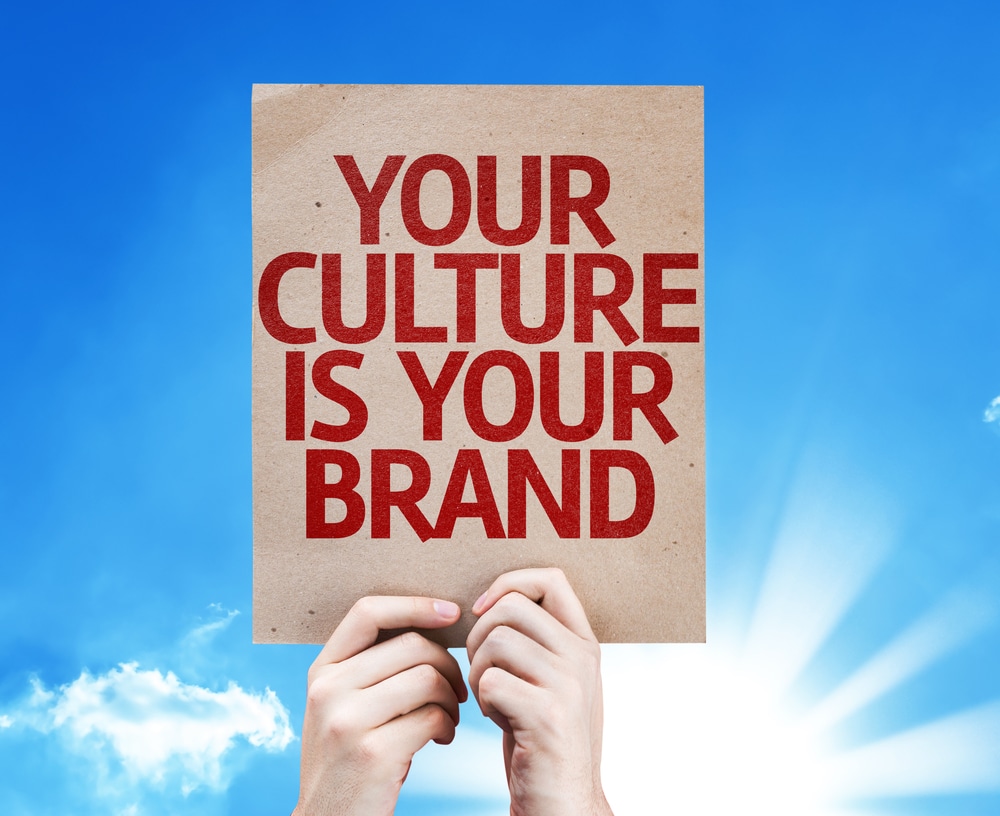
Ah, culture – illusive, tangible yet intangible. You can feel it but it is hard to describe. Is it quantifiable? Or qualifiable?
Workplace culture is vital to successful organizations. When workplace culture and brand culture are aligned, it drives productivity and growth for the organization and its employees, and increases brand loyalty and customer acquisition.
This article will examine how to bring brand culture into the workplace to catalyze changes in attitudes, actions, and behaviors.
To watch as a video
To listen as a podcast
The Latin root of the word, “cultura”, means to grow, or to till. An organizational culture is the result of constant cultivation and growth.
“All of us have at least felt culture, even if we didn’t know what it was, in an unhappy or toxic workplace”, or an incredibly positive and healthy environment. (Jenkins, Sally, The Right Call, What Sports Teach Us about Work and Life, Gallery Books, 2023, p. 123.)
The same book tried to describe culture as “unifying principles”, “underlying principles”, “healthy base atmosphere”, “most important values” that bind the whole group together…
“…organizations that have their purposes, sensibilities, and structures in well-arranged synchronicity. That is culture.” (Supra, P. 136.)
Peter Carroll, the head coach of the NFL’s Seattle Seahawks, described it as the most important values. “Who are you? What are you all about, and what are your uncompromising principles? What are you going to stand by, and what do you stand for?” (Supra, P. 121.)
Golden State Warriors coach Steve Kerr said in a 2022 seminar with Harvard Law students and professors: ”I’d say coaching is maybe 25 to 30 percent strategy. Everything else is about communication and what your players feel when they come into the building every day.” (Supra, P. 120.)
As the saying goes: culture eats strategy for breakfast.
Workplace culture is the daily lived experience of leaders, managers, and employees. It is the “personality” of an organization, including shared values, beliefs, priorities, communication styles, all of which add up to “the way we do things here.”
“Workplace culture is the ‘energy’ of an organization”, per Dr. Victor Porak de Varna, founder and the people expert at TEP.Global.
For leadership coach Mike Pelfini of ForeMeta Coaching, action and behavior define workplace culture. It is essential to look at the “real work that real people do every day.”
“Leaders must explicitly define and set expectations for the company culture they want to create,” according to Rachel Burr of Catamentum Leadership Coaching.
In a 2023 survey of 500 CEOs, 71% said that workplace culture is a top factor for improving financial performance, with 33% saying it is the most important factor. But a recent Gallup Survey found that only 40% of leaders, and just 20% of employees overall, feel “strongly connected” to their organization’s culture, leading to a lack of engagement and lost productivity. According to a 2024 survey, only 33% of employees are actively engaged at work, which costs the U.S. economy $1.9 trillion in lost productivity each year.
When workplace culture is out of step with an organization’s brand identity, principles, and strategic goals, a culture transformation is needed to improve engagement, productivity, and profitability.
Called by some as the “anthem”, “the battle cry”, “the flag”, The term “brand culture” refers to an organization’s values, ideals, beliefs, principles, identity, symbols, and how they connect with their customers, workforce, and stakeholders. Brand culture creates a sense of belonging, purpose, and connection for both the workforce and customers who become “fans”, supporters, and followers of the brand. Workplace culture can and should be embodied in the brand culture.
As the world is going through rapid technological changes, organizations are struggling to keep up with new expectations from employees and stakeholders for ground shifting changes in corporate culture. Too often employees feel disconnected from brand culture, resulting in an unmotivated, uninformed, and disengaged workforce. To be successful, organizations must not only identify the core values that define the brand, but also the attitudes, actions, and behaviors that drive those values.
The first step is to describe a desired brand identity. According to Dr. Vic of TEP.Global, “Shared values, beliefs, and purposes are not only the foundation for company culture but also the foundation for brand identity.”
What values and beliefs does the organization stand for? It’s important to be specific. Using words like “innovative,” “human centered,” or “disruptive” isn’t much help. The words are vague and don’t distinguish the organization from its competitors. Instead, describe the organization’s values and beliefs in terms of the actions, behaviors, and attitudes that drive them. If the organization wants to be perceived as “innovative,” what behaviors and attitudes make that possible? What behaviors and attitudes make the organization “human centered”? Be as specific as possible.
This step requires a deep dive into the organization’s brand DNA and value propositions. The organization should ask how its core values and beliefs align with those of its workforce, customers and stakeholders. When the organization knows itself, its people, its customers and stakeholders, it will know what intrinsic qualities and external messages resonate with them, and which attitudes, actions, and behaviors support its brand culture.
The next step is to align the workforce with brand culture. Two thirds of cultural transformations are unsuccessful, according to McKinsey. The failure to involve employees and other stakeholders is a big reason why. It’s important to avoid a “top down” process. Leaders cannot expect wide acceptance of a new direction without involvement from all levels of the organization.
For Rachel Burr, the key to transformation is to “live the culture.” That means closing the gaps between an organization’s “espoused values” (i.e., what we say we do) and its “values in practice” (i.e., what we actually do).
In other words, actions speak louder than words.
Begin by finding out exactly what the current workplace culture is. This can be done by seeking feedback through surveys, focus groups, and interviews. The goal is to find out exactly “how we do things around here.”
But, you cannot read the label of the jar you are in. You do need outside perspectives from experts (in 10 Plus Brand and our partners, for example) to help you.
Once leadership has gathered information on the existing culture, it can make strategic decisions to align workplace culture with brand culture. Again, it is crucial to involve different levels of the organization.
Front-line workers and their managers have practical information about what is working, what is not, and what changes can help the transformation, per Jerry Briggs, CEO of ApexCX. Involving employees in defining new behaviors will also help achieve their buy-in. People are more likely to support a change if they feel safe expressing themselves to management, and have a role in making the changes.
Seek the frontline workers’ input and feedback with respect and humility, make it safe for them at all times to voice concerns and suggestions. Then follow up with action.
Leaders need to:
(1) communicate the need for change,
(2) become role models for change, and
(3) recognize and reward change.
Organizations need to focus on specific changes, according to Mike Pelfini. It isn’t enough to call for more “collaboration” or “innovation” without defining exactly what those terms mean, and what behaviors express them. Focusing on a few key behaviors will make adoption more likely.
The first step is to communicate the need for change. According to Rachel Burr, the keys to communicating change are the Head, Heart, and Hands. To engage the Head, communication must be clear. To engage the Heart, it must be inspiring. To engage the Hands, it must be actionable.
Leaders will need to talk about change and its benefits “again, and again, and again, and again”. If the employees have been engaged in suggesting ideas for the change from the start, delivering the message and implementing the change will be easier.
Second, leaders will also need to be role models and cheer leaders for change. Being a role model means demonstrating the new attitudes and behaviors through their daily actions. Being a cheerleader means recognizing and rewarding changed behavior early and often.
The third step is to encourage and reward changed behaviors. Dr. Steve Kerr (the exact same name as Warrior’s coach, but NOT the same person), a global authority and author of “Reward Systems” in organizations, advised General Electric’s legendary CEO Jack Welch over a decade. He wisely said that for the workforce to perform and deliver organizational goals, leaders need to define, measure and reward performance. Since it’s not enough to solely rely on selecting or training only those individuals whose goals and motives are wholly consonant with those of management. There needs to be an effective reward system that rewards the right behaviors, performance, and results, for the right goals, in the right way, and must be measured correctly, which in turn are dependent on clear, shared, agreed upon, overarching goals.
Dr. Kerr ingenuity simplified it into “The bull’s-eye exercise: Making mission, vision, and principles actionable”: In the center of the bull’s eye (the target) – Actions or Behaviors; In between the inner and outer bull’s eye – Thoughts and Emotions; The outer bull’s eye: Mission, Vision, Principles. (Kerr, Steven. Reward Systems. Harvard Business Press, 2009. p. 16.)
“We need to first be very clear about what desired results are, and what performance will lead to the desired results, before devising appropriate rewards, to avoid the ‘folly of rewarding A, while hoping for B’”, said Joanne Z. Tan, CEO of 10 Plus Brand, Inc, in her interview with Dr. Kerr.
Change is a long term process that requires constant reinforcement and adjustment to succeed. Transforming workplace culture is a major undertaking. But beginning the process by defining brand culture can catalyze a workplace cultural change. “Brand culture embodies workplace culture. Brand culture can catalyze changes in company culture by aligning attitudes, actions, behaviors with brand values. Aligning brand culture with workplace culture raises productivity, profit, and brand loyalty”, per Joanne Z. Tan, global brand strategist, brand building and branding expert.
One approach is to use rebranding, or brand refreshing. To find out how, please contact us at www.10PlusBrand.com.
10 Plus Brand is a globally recognized brand building, brand marketing full service agency. Our consultants, coaches, AI Experience Design (AIXD) experts have elevated many company brands and personal brands. We advise corporate leaders in brand culture, workplace culture, and related issues.
© Joanne Z. Tan All rights reserved.
====================================================================================
– To stay in the loop, subscribe to our Newsletter
– Download free Ebook
Please don’t forget to like it, comment, or better, SHARE IT WITH OTHERS, – they will be grateful!
(About 10 Plus Brand: In addition to the “whole 10 yards” of brand building, digital marketing, and content creation for business and personal brands. To contact us: 1-888-288-4533.)
– Visit our Websites:
Phone: 888-288-4533
– Find us online by clicking or follow these hashtags:
